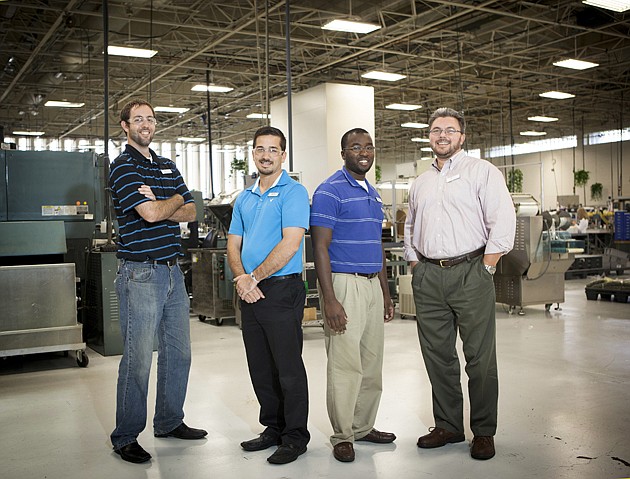 The management style at Sun Hydraulics is so efficient it doesn't even have managers.
The management style at Sun Hydraulics is so efficient it doesn't even have managers.
It's one of several unique characteristics of the firm's horizontal, or flat, system of work. The foundation of the system, created by Sun co-founder Bob Koski in 1970, is hierarchy charts will cripple a company. It will delay decisions and force employees into defensive groupthink mentality.
Al Carlson, CEO of the screw-in cartridges and hydraulic valve manufacturer, with $204.3 million in annual sales, says he even prefers the term leadership over management. He says that more accurately describes how the 700-employee firm has prospered over four decades.
Koski, who died in 2008, wrote a 34-page report in 1970 named “Sun Hydraulics Corporation: Plans and Objectives.” That report detailed his ideals of how to run a company. The report has become something of a guidebook at Sun, which has operations in seven countries, including the United States.
Sun's horizontal leadership strategy has received a stream of press over the years, including stories in Forbes, Fortune and BusinessWeek. A group of Harvard Business School professors also wrote a lengthy study on the company in 1991. The publication has since run several updates on Sun, one in 2003 and one in May 2009 on how it adapted to the recession.
Below is a look at how six Sun employees utilize horizontal leadership.

Employee: Neil Hubbard
Length of service: 22 years
Role: Leadership, manifold design engineering
A Bradenton native, Hubbard got a job with Sun right after he graduated Manatee High School in 1991. “It's the only place I've ever known,” he says, “but it's a great place to work.”
He's currently an “area lead” in manifold design, where he oversees projects. “We have a great bunch of guys, so there's not a lot of leading to do,” Hubbard says. “I believe in minimal management.”
Hubbard, 42, has worked in six departments during his 22 years with the company — being able to move around and try different things is a hallmark of Sun's leadership system. Another trait, from Hubbard's perspective, is it fosters collaboration among employees. Says Hubbard: “We are able to get things done a lot faster.”
Flat management, Hubbard has learned, works best when everyone on a given project has a voice in the work, and outcome. “You don't want someone who is going to be quiet and meek,” he says, “but you also don't want someone who is going to be overbearing.”
Hubbard says he never feels bored at work, another common theme among employees. He adds that Sun's leadership system is what “he lives and breaths,” and he can't envision working for a business with a traditional organizational chart. If he did, he says he would “probably just wither and die.”

Employee: Ervin Scott
Length of service: 2½ years
Role: Operations support engineering
Scott has comparative experience of why Sun's flat system works so well. That's because the University of South Florida grad, with a degree in mechanical engineering, interned at both Sun and a St. Petersburg-based manufacturer with a traditional management hierarchy while in college.
The differences, says Scott, are stark.
“It takes a certain kind of person to work here,” says Scott, 26. “I feel like a I get free roam here. You have a real sense of ownership.”
There are several tangible differences between Sun and the other firm, says Scott, a Jacksonville native. Purchasing is one example. At the other business, Scott says everything he needed to buy while he worked on a project, down to a lug nut, required a form and supervisor approval. “Even if it was only a few dollars,” he adds.
But Sun employees are entrusted to buy what they need on their own, even at costs around $10,000. No forms necessary.
Another difference: staff meetings, or lack thereof. Scott says his group is in constant communications, so they don't hold meetings often. “If something needs to be said, it gets said,” Scott says. “No one waits for the Wednesday meeting.”

Employee: Eric Hare
Length of service: 8 years
Role: Leadership, cartridge operations
Even after eight years, Hare, 34, remembers his hiring process at Sun like it just happened.
The process, he says, is a key attribute of Sun's horizontal leadership. It includes a screening with an industrial psychologist; character assessment tests; and multiple interviews with a cross-section of Sun employees. Then, after all that, the first three to six months are spent on what the firm calls tours, where new employees see how each department runs day to day.
Hare, like most others at Sun, has held several different positions during his tenure. And, like the others, he values the autonomy and red tape-less environment. “That makes it easy to get stuff done,” says Hare, “because you are your own manager.”
Hare worked for Husco International, an electro-hydraulic valve manufacturer, in his native Wisconsin before he moved to the area. He did a little bit of everything at Husco, too, though that firm didn't have the same type of management.
Hare's passion at Sun, moreover, stems from what he doesn't have: a title.
“I could care less what you call me,” says Hare. “But I just want to pitch in and help the company any way I can. If it sounds like I'm drinking the Kool-Aid, I am.”

Employee: Tricia Fulton
Length of service: 16 years
Role: Chief Financial Officer
In a 700-employee company with few formal titles, Fulton stands out because she and CEO Al Carlson are some of the only ones with actual titles.
Fulton, though, would rather tell people she works in the finance department. The title is a strict formality, a Securities and Exchange Commission requirement for publicly traded companies. Says Fulton: “We always joke that the only reason we have titles is so they will know who to send to jail if something goes wrong.”
But Fulton recognizes her job is a serious one, and she tackles it differently than many other corporate financial executives. For one, Sun doesn't rely on budgets and forecasts to plan spending.
“We all agree that the one thing about a budget is that it's always wrong,” says Fulton. “So when you use that you make choices based on information that's wrong.”
The company, instead, controls spending on a project-by-project basis, with a big nod to trust. “It's so inherent in our culture,” says Fulton, “that you spend Sun's money as you would spend your own money.”
Fulton has a background in public accounting, including a stint with Deloitte and Touche in Detroit from 1989 to 1991. She learned quickly at Sun that “people who like being told what to do all the time won't last very long here.”
That kind of environment, she says, fit her work ethic. And now she's become a de facto spokesperson for Sun's horizontal leadership when she's out in the business community.

Employee: Tim Twitty
Length of service: 20
Role: Corporate director and operations leadership
Twitty, currently overseeing a $19 million expansion at Sun, is one of a few employees who came to the firm after he worked for another local manufacturer.
Twitty worked for electronic component maker Hi-Stat Manufacturing in the early 1990s. The transition to Sun was an eye-opening career change. “It was definitely unique to me when I came here,” says Twitty. “Being flat and horizontal allows you to do a lot of things in the company. People don't wait around for someone to tell them what to do, and that's a pretty unique thing I haven't seen anywhere else outside of Sun.”
Adds Twitty: “We don't have silos.”
That open space provides Twitty an opportunity to tackle dozens of tasks he wouldn't have had the chance to do at most other companies. Or, quips Twitty, at Sun “the reward for a job will done is to the opportunity to do more.”
Twitty, 46, says one reason flat leadership works so well at Sun is employees recognize collaboration is a necessity, not a luxury. That's why it helps to have employees who get along well with others.
Sun, however, isn't always Sesame Street. “It doesn't mean we don't challenge each other,” says Twitty. “Sometimes we do challenge each other, and that's OK.”

Employee: Seth Spalsbury
Length of service: 6½ years
Role: Operations support engineering
Spalsbury knows how good he has it at Sun when he goes to Orlando every month for graduate school. He's studying for a master's in engineering management at a University of Florida satellite campus.
His classmates there work for other manufacturing and engineering entities, from Lockheed Martin to NASA, and they are in awe of Sun's flat leadership. Says Spalsbury: “To hear them talk about the red tape and bureaucracy they have to go through makes me feel good about my company.”
Still, Spalsbury, a Sarasota native, says it took some time for him to get used to the intricacies of flat leadership. The fact that few people have job titles, for one, was something he was unsure about at first. But an advantage to that, he's discovered, is a lack of titles requires people to treat everyone the same and focus on work and tasks.
The system has taught Spalsbury teamwork and collaboration skills, but it's also taught him how to rely on himself. “People show up and expect to be handheld and fed stuff,” he says. “But that's not how it happens.”


 The management style at Sun Hydraulics is so efficient it doesn't even have managers.
The management style at Sun Hydraulics is so efficient it doesn't even have managers.









